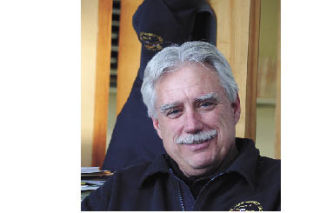Jim Ghiglione, Lopez fire chief, is no stranger to wearing several hats. He has served as the Lopez Fire Department Chief since July 2008, but prior to that, he worked in Shelton, Washington for 27 years. He went from a firefighter to a lieutenant, and then was promoted to assistant fire chief, but he also served simultaneously as the fire marshall, the building official and the building inspector. Shelton is a small town, like Lopez, and Ghiglione knows and respects the multiple contributions that community members make.
Ghiglione said, “We are always, always looking for volunteers in firefighting and EMS (emergency medical services). We are doing pretty well in the EMT (emergency medical technician) area, but we are a little short on the firefighting end, recruit-wise. Right now, it’s common for small departments to have firefighters, firefighters with EMT certification, and EMT’s only with no firefighting certification.”
The requirements for fire fighting are not onerous: males and females must be at least 16 years of age and in reasonably good health. A medical physical is involved and will be paid for by the fire department. “The main commitment,” said Chief Ghiglione, “is the volunteer’s time. The fire department pays for calls and drills…any mileage expenses and wear and tear on vehicles…laundry services, for example, and all protective gear and first aid supplies are paid for. The volunteer gives his or her precious time. This is what the volunteer gives to the community.”
The time a volunteer can expect to give on a regular basis is, for EMT’s and firefighters who are EMT’s, the first and third Tuesday night of the month, and second and fourth Tuesdays of the month for firefighters.
“Initially, a new firefighting recruit will need to devote three hours on Tuesdays and six hours on Saturdays for about three months. The hardest part for volunteers is that they need to be able to make a commitment for the full three months because it is very difficult to make up classes. The same time issue applies to the EMT recruits, but they need four months instead of three months to complete their training. One weekday for three hours in the evening, six hours on Saturday, and they can’t miss class because a recruit can’t make up the classes. The recruits work in teams of four to six people, and it’s virtually impossible to get the other people together to demonstrate the skills necessary in a make-up class. That basic commitment of time is very important to the training. There are other trainings throughout the year that a volunteer must make themselves available for as well, otherwise the volunteer will not be used on calls.”
“After their training,” said Ghiglione, “a regular volunteer is expected to participate in 26 drills a year.” The program needs 30-35 trained firefighters, and right now they have 25 trained firefighters. Currently, the fire department is in good shape on the EMS side. Ghiglione commented, “It is a constant cycle of recruiting, retaining, and training. The physical strength piece is not as big for volunteers as it is for professional firefighters; 25 pounds is the requirement for lifting. Age and gender are not as big of an issue as many people believe.”
“We had a high school volunteer program at one time and I would love to resurrect that. I would really like to recruit some sophomores and juniors, young men and women. We are also going to try and run an early spring firefighting recruitment class and we need a minimum of six volunteer recruits for that. If we had six to twelve people, that would be even better.”
The work the fire chief does is considerable. He is responsible for making sure that, when volunteers go off-island for training, he has enough volunteers in both firefighting and EMT training to be in force on the island in the event of an emergency. This is one of the issues the department faces when they are low on volunteers. Also, for a volunteer force to operate safely on a fire ground (a building on fire) the chief needs at least twenty people on-site to safely put the fire out. To do that, he needs a force 30-40 percent bigger than twenty people, as he must be able to adjust for volunteers out training, or ill, or off-island.
“It’s rewarding to be a volunteer firefighter.” Ghiglione points out. “When someone dials 911, you know you are helping your neighbor in their time of need. After the job is done, the people are grateful that you were there, and especially appreciative for your time and expertise. There is not a huge financial incentive, but the ability to help an island community member is priceless. We can provide the volunteer and their family with the air lift insurance, and there is a pension benefit through the Washington State board



